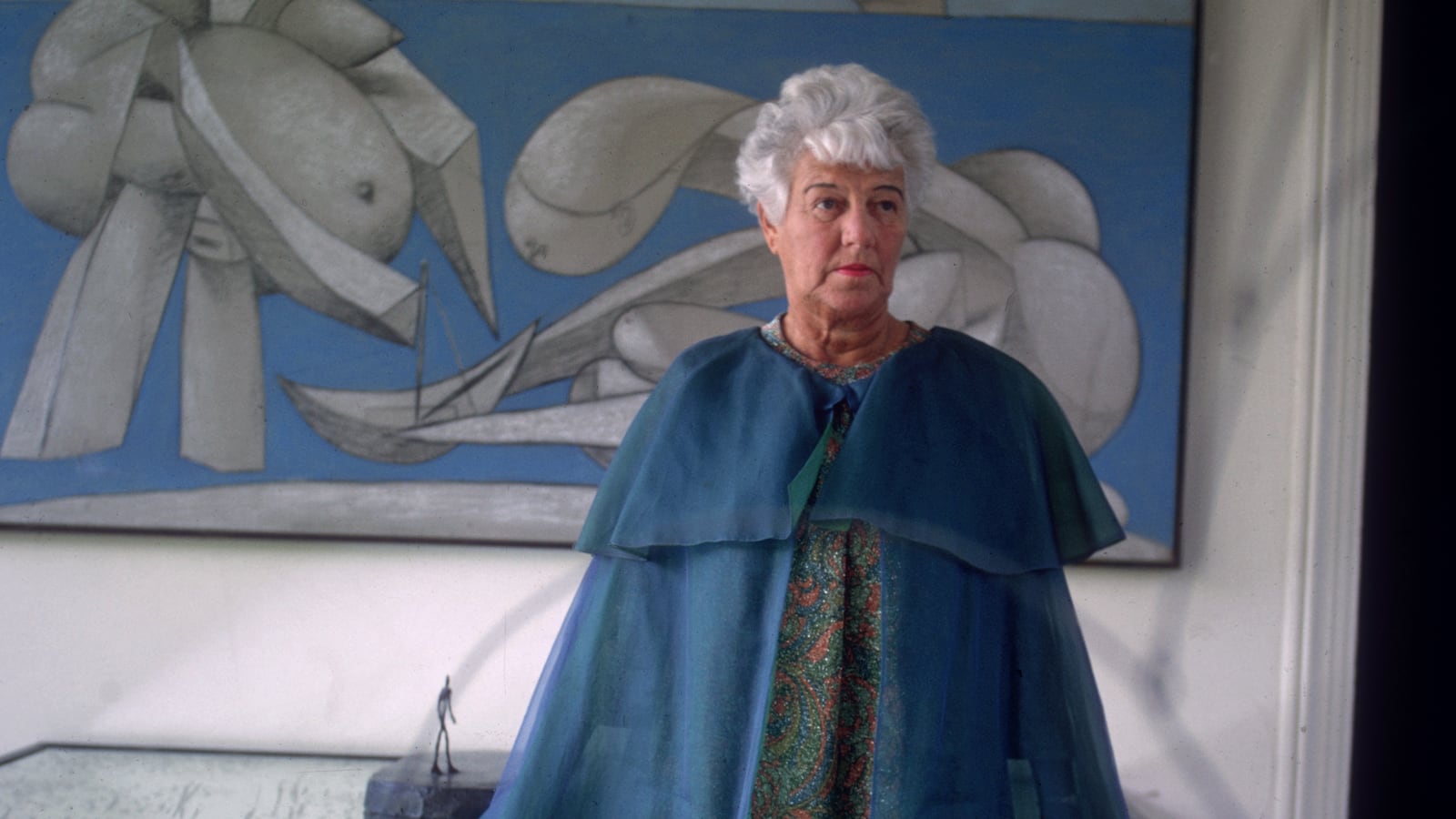The Peggy Guggenheim Collection sits on the banks of the Grand Canal in Venice, a somewhat unassuming one-story, white-walled palace that is filled with one of the most visited collections of modern and contemporary art in the world.
Millions of art lovers have pilgrimaged to its shore to see the Pollocks and Kandinskys, the Calders, de Koonings, and Dalís, the Duchamps and Ernsts that line its walls.
It is not only one of the premier collections of modern art in the world, featuring over 300 works by over 100 of the most influential artists of the 20th-century, but it also has played an integral role in turning Venice into a mecca for contemporary art.
But, outside of professional art circles, what is less well known is the singular life of the woman who made assembling the collection her life’s purpose.
Peggy Guggenheim—niece of Solomon R. Guggenheim, founder of New York’s Guggenheim Museum—deserves much of the credit for spreading the religion of modern art across oceans. She passionately supported the artists who became the creative geniuses of the movement, promoted their work, and unapologetically slept with many along the way.
A new documentary directed by Lisa Immordino Vreeland explores the life and times of Peggy Guggenheim: Art Addict.
Using a combination of historical footage, interviews with leading artists and art experts, and, most importantly, tapes originally thought lost of the last interview Peggy Guggenheim ever gave to her biographer Jacqueline B. Weld, Vreeland weaves the story of an intriguing, complex woman who overthrew the gender and class expectations of the 20th century to live exactly how she wanted.
Immordino Vreeland is an expert on 20th-century stories of reinvention. Her first documentary, Diana Vreeland: The Eye Has to Travel, opened in 2011 to much acclaim and told the story of her grandmother-through-marriage, Diana Vreeland, who fashioned herself into a larger-than-life and colorfully eccentric fashion maven.
“There’s only one very good life, and that’s the life you know you want and you make it yourself,” Vreeland says in footage used in the film.
But these words could easily have been said by Guggenheim, who lived this mantra down to her core.
Family name and expectations be damned; Guggenheim threw off the strict and constricting bounds of bourgeois life in the elite Jewish society of New York and embraced the bohemian lifestyle of the Parisian avant-garde. She saw the life she wanted, and nothing would stop her from realizing it.
***
Guggenheim grew up in early 1900’s New York, a daughter of two famous immigrant Jewish families—the Seligmans and the Guggenheims. Her childhood was largely unhappy, raised by harsh nannies, a neglectful mother, and a society she didn’t feel she quite fit in to.
When she was 13 years old, her beloved father went down with the Titanic. He had left the family business some years before and had lost a significant amount of money in his own ventures.
His passing left her branch of the family much poorer than the rest (although they still had plenty of money, relatively speaking). “I never considered myself a real Guggenheim anymore after that,” Guggenheim says in the tapes.
In her early 20s, Guggenheim left New York behind and moved to Europe, where she embraced the bohemian mecca of 1920’s Paris.
In some ways, she was an early version of our modern day social media celebrity: she wanted to be known and to be associated with the inspired and boundary-less creative activity happening all around her. But she didn’t have artistic talent herself. So she made it her business to get as close to the art as possible, creating a name for herself by promoting their work.
While she was always passionate about art, Guggenheim’s early love was for the classics—she traveled to obscure corners of Europe to see the greats of the Renaissance. But in modern and contemporary art, she found a movement that was less well known.
“What’s interesting about Peggy is the fact that these were artists that were not famous at the time. They were the underdogs,” Immordino Vreeland told The Daily Beast. “This was the world of the avant-garde that was totally opposite from the way that she was brought up. And she got it.”
Guggenheim had no less a figure than Marcel Duchamp advising her, and she committed to buying a piece a day during the early days of WWII. Because of her early entrance into the market and the desperation caused by the war, she was able to assemble her impressive collection for only $40,000.
***
No story of Peggy Guggenheim can be told without mentioning her impressive sex life. From her early days, she was interested in men (and sometimes women, although she’s a little more coy about that area of her life).
Her autobiography is studded with notes on men she found attractive from an almost disturbingly young age. At 23, she set about losing her virginity, which she found “burdensome,” to her boyfriend and eventual first husband, Laurence Vail.
“I had a collection of photographs of frescos I had seen at Pompeii. They depicted people making love in various positions, and of course I was very curious and wanted to try them all out myself. I think Laurence had a pretty tough time because I demanded everything I had seen depicted in the Pompeian frescoes,” Guggenheim writes about her first time having sex.
Guggenheim was an unconscious feminist. She suffered much physical abuse at the hands of Laurence Vail, but never seemed all that troubled by it. And while she did mount New York’s first exhibition of only women artists, she wasn’t always an overt champion of women’s issues.
But her refusal to live her life by society’s rules and her complete openness about her sexual conquests and appetites made her a revolutionary figure of the time.
Guggenheim was attracted to the creative minds that also filled her collection. In the tapes, Guggenheim notes that while she liked “tall, dark, good-looking men,” many of her lovers didn’t fit this type—they were the artists whose work she believed in.
“I think that everybody talks about her sex life, and, of course, we covered it pretty extensively in the film. But we had to cover it extensively in the film, because she talks about it herself,” Immordino Vreeland says. “And that’s what makes her a feminist in her own funny way. Because she had the guts to do that and the courage to do that, and it was totally unlike what anybody would do back then.”
Guggenheim married twice, first to Vail, with whom she had two children—Sinbad and Pegeen—and later to artist Max Ernst.
Neither marriage lasted, although Vail became one of her best friends later in life. She wasn’t a particularly good mother: she allowed Vail to have primary custody of Sinbad after their divorce in order to take a new lover, John Holms, “who was the greatest love of her life,” according to the Guggenheim’s website.
Though she tried, she was ill-equipped to deal with her daughter Pegeen’s emotional problems. “She was a byproduct of her upbringing, so she really didn’t know how to be a mother,” Immordino Vreeland says.
***
Guggenheim’s life was full of contradictions. She dedicated herself to nurturing the artists she loved, but she didn’t know how to be a mother to her two children. She was incredibly generous with her fortune, yet was also legendarily cheap when it came to things like food for the gatherings she hosted salon-style in her home.
But Guggenheim lived a life of courage in so many ways. She was one of only a few women working in an art world dominated by men. She was instrumental in helping to safe-guard artists and the contemporary art Hitler detested in the U.S. at the outbreak of WWII, claiming she didn’t fear for herself, only her collection.
She also helped make New York City a hotbed of modern art during a time when it wasn’t yet respected in the city. She counted discovering and championing Jackson Pollock as her biggest achievement, closely followed by assembling her art collection.
Peggy Guggenheim: Art Addict builds out these complexities, showing the queen of modern art in all of her strong-willed and eccentric glory. After the war, Guggenheim decided to settle in Venice. It was to become the last chapter of her colorful life, while also encapsulating her purpose and philosophy of living.
Venice was a fairly conservative city at the time, and then the audacious American rolled in, showing her outrageous, modern art at the first post-war Biennale in 1948.
She bought the Palazzo Venier dei Leoni in 1949 as a home for herself and her collection (it remains the home of the Peggy Guggenheim Museum today), throwing parties and entertaining guests and lovers there.
While she may have shocked the more traditional Venetian residents, Guggenheim was instrumental in changing Venice forever and establishing its current reputation as the city of contemporary art.
“She was living there and she was a single woman living a wild life of whatever men that were in town. She had this really, really cute Italian boyfriend, and there’s this whole conversation of people coming and visiting her…She was the social mecca. But she went there for this purpose of wanting to build a museum,” Immordino Vreeland says.
Guggenheim was always interested in giving back, following the philanthropic tradition of her family. “Once she decided that she wanted to collect art, she wanted to share it with the world,” Immordino Vreeland says.
In 1951, Guggenheim opened her Palazzo to the public, allowing them to visit and view her art collection. At the end of her life, Guggenheim decided to donate her collection to her uncle Solomon’s foundation, with one condition: it must stay in Venice. This not only solidified Venice’s place in the contemporary art world, but it also gave New York’s prominent Guggenheim Museum international presence and influence.
“It’s horrible to get old. It’s one of the worst things that can happen to you. But I really felt I accomplished what I wanted to do, and I’ve done it very successfully, and I’m very happy about that,” Guggenheim says on the tape.
“[Guggenheim’s story] is about passion in the end, it’s about the passion to do something,” Immordino Vreeland says. “And I think that that is such an important conversation for [the younger] generation.”
Guggenheim died in 1979 at the age of 81, but she remains with her art at the Palazzo Venier dei Leoni, buried in a courtyard of the Peggy Guggenheim Museum with 14 of her beloved dogs. “You just kind of feel her spirit there. It’s a magical place to be,” Immordino Vreeland says.






